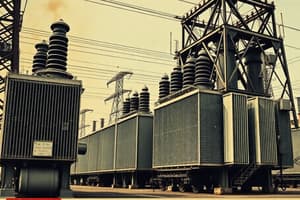Podcast
Questions and Answers
What is the primary function of a transformer in electrical engineering?
What is the primary function of a transformer in electrical engineering?
- To convert AC to DC
- To transfer electrical energy between circuits (correct)
- To amplify electrical signals
- To generate electrical energy
What is the underlying principle behind the operation of a transformer?
What is the underlying principle behind the operation of a transformer?
- Kirchhoff's current law
- Lenz's law
- Ohm's law
- Faraday's law of induction (correct)
What is the result of a varying current in any coil of a transformer?
What is the result of a varying current in any coil of a transformer?
- No effect on the magnetic flux
- A constant electromotive force (EMF)
- A constant magnetic flux
- A varying magnetic flux (correct)
What is the key characteristic of energy transfer between coils in a transformer?
What is the key characteristic of energy transfer between coils in a transformer?
When was Faraday's law of induction discovered?
When was Faraday's law of induction discovered?
What characteristic of a wave changes as it travels across a boundary between two different media?
What characteristic of a wave changes as it travels across a boundary between two different media?
What is the increase in velocity of sound in air for every 1°C rise in temperature?
What is the increase in velocity of sound in air for every 1°C rise in temperature?
What is the definition of a photon?
What is the definition of a photon?
When a ray of white light is refracted, which component color has the greatest change in direction?
When a ray of white light is refracted, which component color has the greatest change in direction?
Which group of particles can be accelerated by a cyclotron?
Which group of particles can be accelerated by a cyclotron?
Study Notes
Waves and Light
- When a wave travels across a boundary between two different media, its frequency remains unchanged, but its wavelength and speed change.
- As temperature increases by 1°C, the velocity of sound in air increases by 0.6 m/s.
Photons and Electromagnetic Radiation
- A photon is a particle of electromagnetic radiation.
Refraction and Light
- When a ray of white light is refracted, violet light has the greatest change in direction.
Particle Acceleration
- A cyclotron can accelerate protons, alpha particles, and deuterons (not neutrons or electrons).
Wave Properties
- The amplitude of a wave is independent of its velocity, wavelength, and frequency.
Transformers in Electrical Engineering
- A transformer is a passive component that transfers electrical energy between circuits without a metallic connection.
- A varying current in one coil induces a varying electromotive force (EMF) across other coils wound around the same core, enabling energy transfer.
- Faraday's law of induction, discovered in 1831, describes the induced EMF.
Studying That Suits You
Use AI to generate personalized quizzes and flashcards to suit your learning preferences.
Description
Test your knowledge of transformers, a fundamental component in electrical engineering, and how they transfer energy between circuits without a metallic connection. Learn about the principles of magnetic flux and electromotive force (EMF) in transformers. Evaluate your understanding of this crucial concept in electrical engineering.




